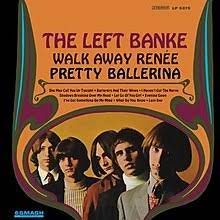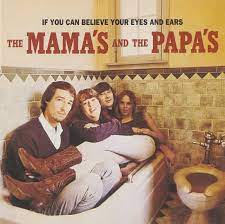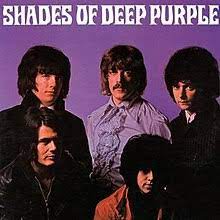Pricing: $3.25ea OR any 10 for $10
(use code "Any10410" at checkout)
Paid Requests for $25ea
(comes with any 8 freebies -> so 9 for $25)
100's Of Free Demos & Chord Sheets
1960s Nostalgia: Discovering the Enduring Hits
Songs from The Monkees

Welcome to a music lover's paradise, dedicated to the smooth harmonies, infectious melodies, and timeless rhythms of the Monkees. This page brings you a wealth of information about the songs from the Monkees, the rock band that defined the musical landscape of the 60s and continues to influence popular culture.
Below are several of The Monkees songs you can easily learn on the acoustic guitar by using my free pdf chords and lyrics sheets and watching my free video demos.
If you require a full instructional video tutorial you can get one for a small fee. Discount pricing listed above.
Jump menu to quickly access the artists on this page.
The Monkees Song Vault
Ready to immerse yourself in the discography of The Monkees? A virtually exhaustive list of their work, complete with album names, song titles, and release dates, can be found on popular music streaming platforms, such as Spotify, Apple Music, and YouTube. These platforms not only let you stream iconic Monkees hits like "Daydream Believer", "I'm a Believer", and "Last Train to Clarksville" but also provide an easy download option for offline listening.
If you prefer a tangible form of music collection, The Monkees' albums are widely available for purchase on CD and vinyl at leading online music retailers as well.
On this page I cover six popular Monkees songs.
Songs From The Monkees - Chords & Lyrics, Demos & Full Lesson Tutorials
1. A Little Bit Me A Little Bit You
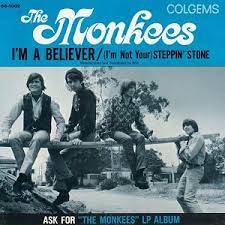
A Little Bit Me, A Little Bit You is a song written by Neil Diamond, which was recorded and released by The Monkees in 1967. The song was produced by Diamond's frequent collaborator, Jeff Barry, and reached No. 2 on the Billboard Hot 100 chart.
The song is known for its catchy melody and upbeat lyrics, which describe a relationship where both parties are willing to compromise and make sacrifices for each other. The opening lines, "Walk out, Girl, don't you walk out / We've got things to say / Talk out, let's have a talk / And you could go your way," set the stage for the rest of the song, which highlights the give-and-take nature of a healthy relationship.
The song features a distinctive guitar riff, as well as a memorable brass section and harmonized vocals. It was one of several hits for The Monkees in the mid-1960s, and helped cement their place as one of the most popular bands of the era.
Interestingly, "A Little Bit Me, A Little Bit You" was actually a solo recording by Monkees member Davy Jones, with the other band members providing backing vocals. Jones was one of the most popular members of the group, known for his boyish good looks and energetic stage presence.
- Drop D Tuning = No
- Capo = 3rd fret
- Rhythm = down down up down up down -- up up up down up down up and repeat
- Picking = No
- Chords = A, D, G, D/Gb, Em
Jump To Top Of Songs From The Monkees
2. Daydream Believer
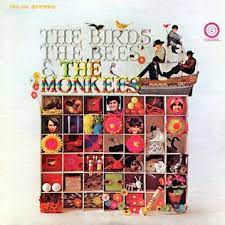
Daydream Believer is a song that was written by John Stewart and originally recorded by The Monkees in 1967. The song became one of the band's biggest hits, reaching number one on the Billboard Hot 100 chart in December of that year.
The song features a catchy melody and optimistic lyrics that encourage listeners to pursue their dreams and not give up on them. The opening lines, "Oh, I could hide 'neath the wings / Of the bluebird as she sings / The six-o'clock alarm would never ring," suggest a desire to escape from the daily grind and embrace a more carefree existence.
"Daydream Believer" features lead vocals by Monkees member Davy Jones, and showcases the band's signature pop-rock sound, with jangly guitars, bright harmonies, and upbeat percussion. The song also features a memorable piano riff, played by session musician Mike Melvoin.
The song's success helped solidify The Monkees' status as one of the most popular bands of the 1960s, and it has remained a beloved classic in the years since its release. The song has been covered by numerous artists over the years, and has been featured in a variety of films, television shows, and commercials.
- Drop D Tuning = No
- Capo = No
- Rhythm = mainly downstrokes in the beginning ... then a steady down up down up and repeat and some shuffle drum roll rhythm
- Picking = No
- Chords = G, C, Am7, G6, Em, D, D7, Bm, A7
Jump To Top
3. I'm A Believer
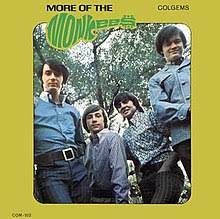
I'm a Believer is a song written by Neil Diamond and originally recorded by The Monkees in 1966. The song was produced by Jeff Barry and features lead vocals by Monkees member Micky Dolenz.
"I'm a Believer" became one of The Monkees' biggest hits, reaching number one on the Billboard Hot 100 chart in December 1966 and remaining there for seven weeks. The song's success helped cement The Monkees' status as one of the most popular bands of the era, and it has since become a classic of 1960s pop music.
The song's upbeat melody and catchy chorus, which features the repeated refrain "I'm a believer, I couldn't leave her if I tried," have made it a favorite of audiences for decades. The song's lyrics tell the story of a man who has been disillusioned by love in the past, but has now found someone who has restored his faith in romance.
"I'm a Believer" features a distinctive guitar riff and a lively drum beat, as well as harmonized backing vocals and a memorable organ solo. The song has been covered by numerous artists over the years, and has been featured in a variety of films, television shows, and commercials.
- Drop D Tuning = Yes
- Capo = No
- Rhythm = down up down up with a riffs
- Picking = Yes and a few riffs
- Chords = D7, G, D, C, G/F, F
Jump To Top Of Songs From The Monkees
4. Last Train To Clarksville
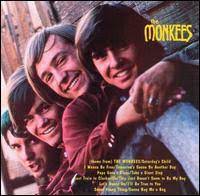
Last Train to Clarksville is a song written by songwriting duo Boyce and Hart and originally recorded by The Monkees in 1966. The song features lead vocals by Monkees member Micky Dolenz and became the band's debut single, reaching number one on the Billboard Hot 100 chart in November of that year.
The song tells the story of a soldier who must leave his girlfriend to go off to war, and urges her to meet him at the train station in Clarksville, Tennessee so they can say goodbye. The song's lyrics are poignant and bittersweet, capturing the sense of longing and uncertainty that comes with separation.
"Last Train to Clarksville" features a distinctive opening guitar riff and a driving rhythm section that propels the song forward. The song's catchy melody and upbeat tempo made it an instant hit with audiences, and it has since become a classic of 1960s pop music.
The song's success helped launch The Monkees' career, and they went on to become one of the most popular bands of the era. "Last Train to Clarksville" has been covered by numerous artists over the years, and has been featured in a variety of films, television shows, and commercials. It remains a beloved classic of the 1960s and a testament to the enduring appeal of The Monkees' music.
- Drop D Tuning = No
- Capo = No
- Rhythm = root down root up down up and repeat with a built in riff
- Picking = just a few riffs in the rhythm
- Chords = G, D7, C7, F
Jump To Top
5. Papa Genes Blues
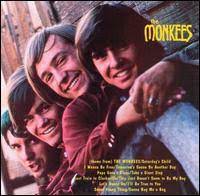
Papa Gene's Blues is a song written by Michael Nesmith of The Monkees, and was included on their 1966 self-titled debut album. The song features Nesmith on lead vocals and acoustic guitar.
The song has a distinctive country-rock sound, with twangy guitar riffs and a bluesy melody that showcase Nesmith's roots in country music. The lyrics tell the story of a young man who dreams of leaving his mundane life behind and striking out on his own, but is held back by his sense of duty to his family and community.
Despite not being released as a single, "Papa Gene's Blues" became a fan favorite and has since become a classic of 1960s rock music. The song's blend of rock, country, and blues influences helped pave the way for the country-rock movement that would emerge in the late 1960s and early 1970s.
In addition to his work with The Monkees, Nesmith went on to have a successful career as a solo artist and producer, and is widely regarded as a pioneer of country-rock and alternative country music.
- Drop D Tuning = No
- Capo = 2nd fret
- Rhythm = root down up down up down up and repeat
- Picking = Yes
- Chords = G, Gb, E7, Am, D7, C, D#
Jump To Top Of Songs From The Monkees
6. Valleri
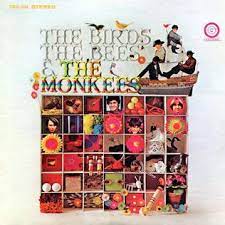
Valleri is a song written by songwriting duo Boyce and Hart, and was recorded by The Monkees in 1968. The song features lead vocals by Monkees member Micky Dolenz and was released as a single, reaching number three on the Billboard Hot 100 chart.
The song's upbeat melody and catchy chorus, which features the repeated refrain "Oh, my Valleri," have made it a fan favorite and a classic of 1960s pop music. The song's lyrics tell the story of a man who is hopelessly in love with a woman named Valleri, and can't help but sing her praises at every opportunity.
"Valleri" features a lively guitar riff and a driving rhythm section, as well as harmonized backing vocals and a memorable organ solo. The song's infectious energy and catchy hooks helped make it one of The Monkees' most popular hits, and it has since become a staple of classic rock radio.
In addition to its success as a single, "Valleri" has been featured in a variety of films, television shows, and commercials over the years, cementing its status as a beloved classic of 1960s pop music.
- Drop D Tuning = No
- Capo = No
- Rhythm = down down up down up down up and repeat will work for this one
- Picking = a few riffs with arpeggio
- Chords = Gm, F, A#, D7, G, C, Em
Jump To Top Of Songs From The Monkees
Behind the Performers

Micky Dolenz (drums and vocals)

Michael Nesmith (guitar and vocals)

Peter Tork (bass guitar, keyboards)

Davy Jones (percussion and vocals)
While the band was often reviled as a "Pre-Fab Four," their talent and ability to perform their hits convincingly resulted in a number of chart-topping hits - not to mention, Dolenz and Jones provided vocals for some of the band's biggest hits.
Cover Love
Besides my own spin on popular Monkees songs, for other fresh takes on the Monkees' hits, one can leap into the world of cover songs from artists in all corners of the music world. These include the likes of Run DMC, Anne Murray, and even the punk band Lagwagon, have put their spin on the timeless classics by the Monkees. Most of these cover versions can be found on YouTube.
Achievements Unveiled
Although initially dismissed as a manufactured band, the Monkees achieved phenomenal success. Their infectious pop anthems delivered a series of Top 10 hits and their piece de resistance, "I'm A Believer," stayed at Number One on the charts for seven weeks.
The Beatles and The Monkees

In the midst of Beatlemania, many viewed the Monkees as America's answer to the British sensation. While the Beatles were initially skeptical, John Lennon later embraced them, stating he "never missed an episode" of their TV show.
Paul McCartney even went on to say that "the Monkees were the funniest comedy team since the Marx Brothers."
In Conclusion
In this unforgettable journey exploring "songs from the Monkees," I hope to have imparted an “educational, fun facts, light read, trivia info," filled page for all ages to enjoy. Whether you're here for a blast from the past or discovering the Monkees for the first time, I welcome you to an engaging lyrical exploration.
Come back for more exciting details as this sensational band continues to resonate in the hearts of music lovers around the world. Enjoy the Monkees' songs and may their music bring you joy, just as they did to millions of fans in their prime.
Thank you for visiting this songs by The Monkees page and I hope you found some useful and helpful info here.
If you liked this songs from the Monkees page, you might also like ... (click images)
Popular Songs From The 60s
